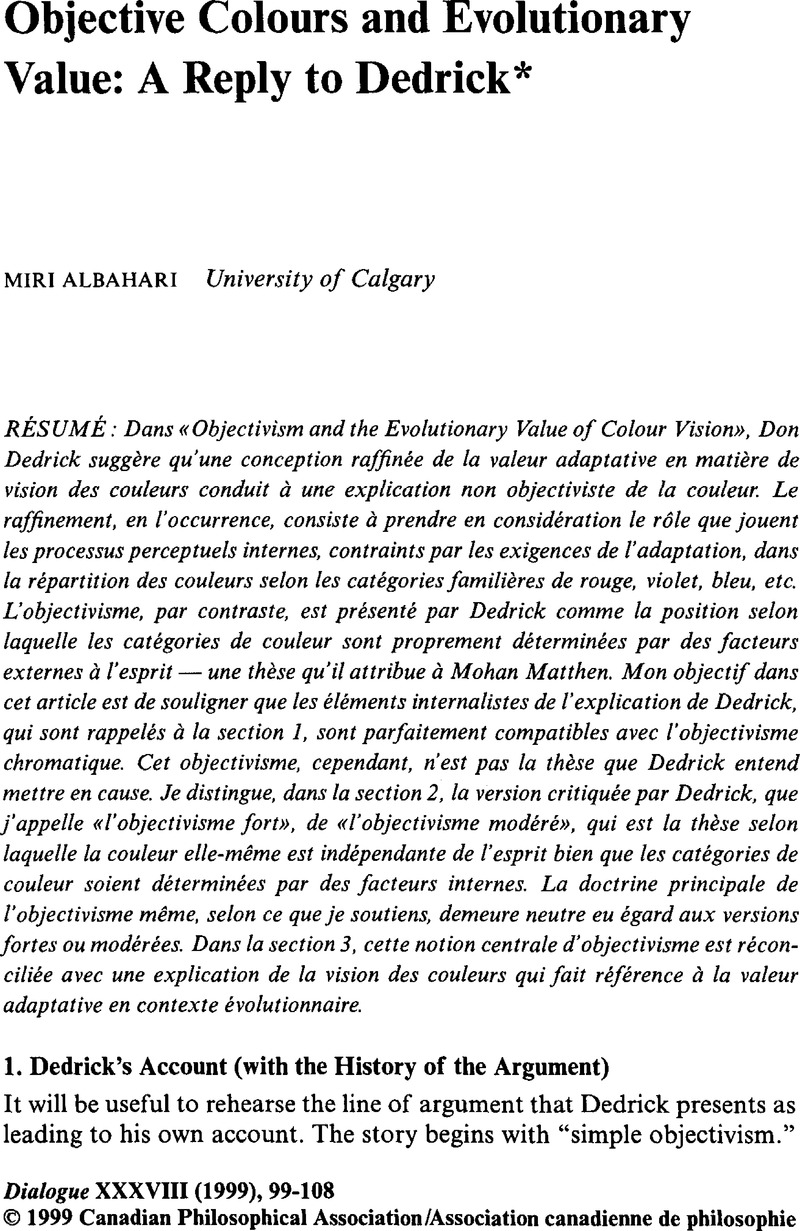Published online by Cambridge University Press: 13 April 2010

1 Dedrick, Don, “Objectivism and the Evolutionary Value of Colour Vision,” Dialogue, 34, 1 (Winter 1995): 35.CrossRefGoogle Scholar
2 Ibid., p. 36.
3 Ibid., p. 37.
4 Ibid.
5 Ibid., p. 41.
6 Ibid., p. 38.
7 Ibid.
8 Ibid., p. 42.
9 Ibid.
10 Ibid.
11 Ibid., p. 43.
12 Ibid.
13 See Jackson, Frank and Pargetter, Robert, “An Objectivist's Guide to Subjectivism about Colour,” Revue Internationale de Philosophie, 41 (1987): 129–30Google Scholar, for a brief account of what it is for an object to look coloured “in the right way.”
14 The distinction between colour itself and colour categories, which is central to my account, corresponds in some way to the oft-cited distinction between determinable and determinate colours. My account, however, emphasizes the categorization of colours rather than the colours categorized, and speaking of determinate colours would capture the latter rather than the former (correct) interpretation.
15 Variations of moderate objectivism are, for instance, developed in Jackson and Pargetter, “Subjectivism about Colour,” pp. 127–41; Sandee, Peter, “Secondary Qualities—Subjective and Intrinsic,” Theoria, 54, 3 (1988): 200–19Google Scholar; and Pettit, Philip, “Realism and Response-dependence,” Mind, 100 (October 1991): 587–626.Google Scholar
16 Jackson and Pargetter, “Subjectivism about Colour,” pp. 131, 133, 141. Jackson and Pargetter's account has been recently challenged by Watkins, Michael in “Colours and Causes,” Dialogue, 36 (1997): 281–85Google Scholar. I suspect that at least one of Watkins's objections is based on a conflation of colour category origins and colour itself, which leads him to misunderstand their account. On this particular objection, he takes Jackson and Pargetter to be making the problematic assertion that if objects O1 and O2 appear the same colour to S but have different physical properties, then they must have different colours (given that colours are properties ascribed to objects) (ibid., p. 283). As Jackson and Pargetter make clear, however, both O1 and O2 have in common the fact that their mind-independent physical properties, however disparate, cause the respective objects to look red to S in circumstance C at time t. (Jackson and Pargetter, “Subjectivism about Colour,” p. 138). It is in virtue of causing the same experiences of redness that these physically disparate properties (identified in each case with redness itself) belong to the same colour category. The fact that both samples of red are physically different has no bearing on the fact that both belong to the category “red,” and, hence, on the fact that both objects have the same colour.
17 Dedrick, “Evolutionary Value of Colour Vision,” p. 37.
18 Shepard, Roger N., “The Perceptual Organization of Colours: An Adaptation to Regularities of the Terrestrial World?” in The Adapted Mind: Evolutionary Psychology and the Generation of Culture, edited by Barkow, J. H., Cosmides, L., and Tooby, J. (Oxford: Oxford University Press, 1992), pp. 509–10.Google Scholar
19 Hardin, C. L., “The Virtues of Illusion,” Philosophical Studies, 68 (1992): 376.Google Scholar
20 In his 1993 edition of Colour for Philosophers: Unweaving the Rainbow (Indianapolis, IN: Hackett, 1993), p. xxvGoogle Scholar, Hardin notes that, although recoverance of reflecting surface information is of central importance to humans, we should bear in mind that “an organism's being able to respond to the spectral characteristics of light, air, and water is also of substantial value.… In light of these and other ecological considerations… it seems risky to speak… of the biological function of color vision and to let much philosophical consequence ride upon its uniqueness.” Hardin does, however, keep to the view that colour vision is “particularly useful for biological signaling” (ibid., p. xxvi). It is this overall function of biological signaling that I propose to identify as the primary function for the chromatic perceptual system. What makes such a system specifically chromatic is the fact that most of the information exploited when serving its function happens to be either a property of surfaces or spectral in its composition.
21 Matthen, Mohan, “Intentionality and Perception,” The Journal of Philosophy, 85, (December 1989): 728Google Scholar. See also Matthen's, “Biological Functions and Perceptual Content,” The Journal of Philosophy, 85, 1 (January 1988): 5–27, for a more detailed account of his position.CrossRefGoogle Scholar
22 Note that my modified schema involves abandoning Matthen's view that perceptual content is to be identified with whatever material it is the biological function of the perceptual system to indicate. I will not enter into a detailed defence of this move, except to point out that the factors which motivated Matthen to adopt his particular view on perceptual content do not present a problem to my account. Briefly, Matthen insists on the following constraints for a theory of perceptual content: (1) unwanted internal material is not included in perceptual content, and (2) the account can deal with misperception: perceptual states that are caused by external factors which are not part of the states' descriptive content. (Matthen, “Intentionality and Perception,” pp. 728–29.) On my schema, (1) it is by definition not possible for internal content to be included in a chromatic perceptual state, and (2) since my schema deals at the level of colour in general rather than at the more specific level of colour category determination, issues of misperception (i.e., misperceiving a particular colour) do not arise.